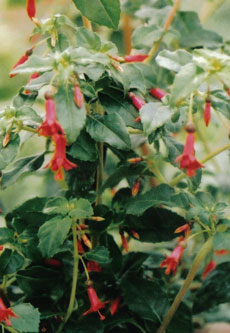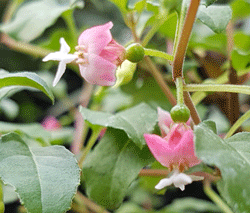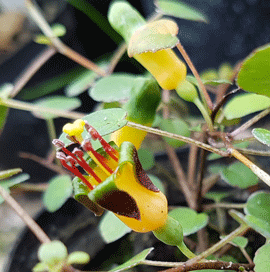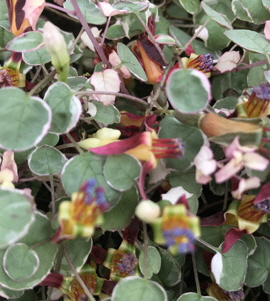|
|
Small Flowered Fuchsias |
|
|
|
|
|
Cinnabarina. (Hardy) 1829 (Raisers unknown) Single. Encliandia hybrid. Tube, Sepals and Corolla orange scarlet. Reflexed. Very small flowers freely produced. Foliage small medium green. Upright.
|
|
|
|
|
Lottie Hobby. (Hardy) 1839 (Edwards). Single. Tube dull scarlet. Sepals similar tipped with rose. Corolla scarlet. Very small flowers, freely produced, small glossy foliage, upright. Looks like species but is a breviflorae hybrid. Hardy in most places. 3-4ft (90cm-1.2m). |
|
|
|
|
Microphylla. (Hardy) 1823 (Kris). Single. Tube deep red. Corolla rosy-pink, paling under glass. Tiny flowers borne singly in the leaf axils. Very small dark green leaves giving fern like effect overall. 2-3ft (75-90cm). |
|
|
|
|
Neopolitan 1984 (D. Clark) Single. Interesting addition to the Encliandra section (miniature flowers). This is a novelty variety with red white and pink separate blooms at the same time. Small fine leaves on bushy plant. Suitable for show work.
|
|
|
|
|
F. Procumbens. (Hardy) 1839 Species. Tube greenish yellow, red at base. Sepals green tipped purple. No Corolla. Stamens bear bright blue pollen. Seed pods turn from green to plum purple and become quite large. Flowers free, very small and points upwards. Growth trailing, suitable for rockeries. 4in (10cm). |
|
|
|
|
F. Procumbens Variegata. (Hardy) Tube greenish yellow. Sepals green tipped, fully reflexed exposing stamens with bright blue pollen. The foliage of the variety is highly variegated, silver green and cream edged with pink distinctive cast. Growth trailing, suitable for rockeries or ground cover. Natural variant of procumbens. |
|
|
|
PLEASE NOTE FOR WINTER MONTHS: H.1. requires greenhouse heated to minimum of 40°F (4.5°C). Although the above classifications are our recommendations, many of our customers are growing fuchsias that we classify as H.2 out of doors with good results and obviously with bigger blooms produced on H.2's than on The RHS and the British Fuchsia Society list many fuchsias that we classify as H2 medium hardy, as H3 hardy and with the climate changes (Global warming) this has probably become a fact |
|
|
|
A B C D E F G H I J K L M N O |
|||






